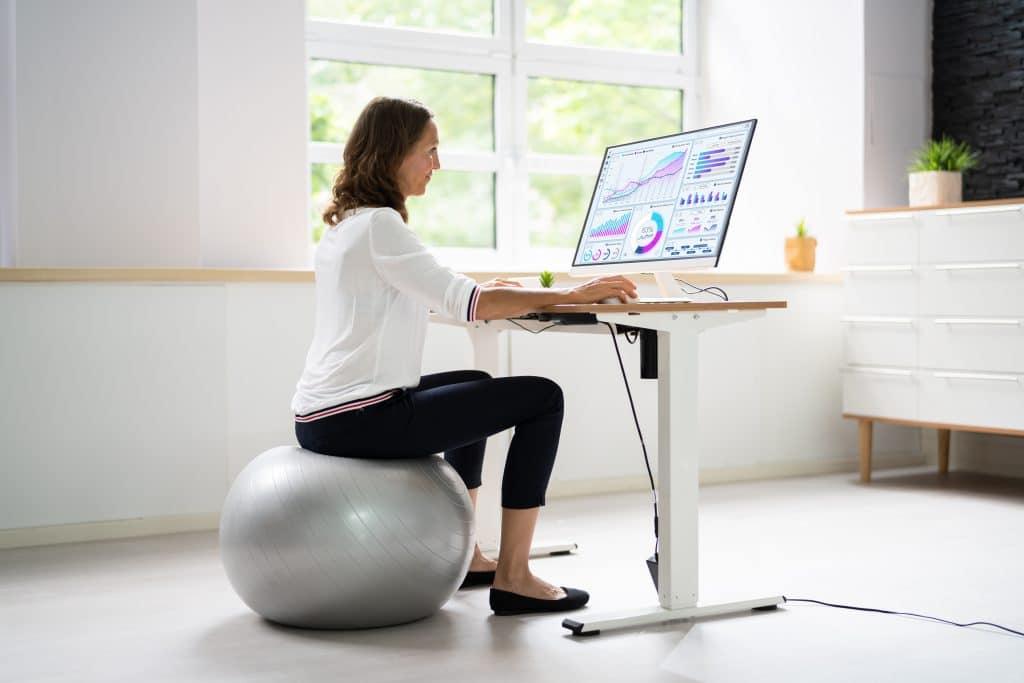Do you wake up feeling achy and stiff in your back and neck, even if you didn’t do anything physically demanding? While there are several different factors that can lead to back pain, most of the time it develops over the course of daily living. Repetitive activities, like reaching overhead or sitting at the computer, can produce muscle tightness and tension. Luckily, there are things you can do to prevent that backache. Here are 5 healthy posture tips to reduce back pain.

1. Understand The Impact Of Slouching
You’ve undoubtedly heard that you shouldn’t slouch, but what’s the big deal, anyway? For starters, too much slouching can actually cause your body to get stuck in that position. The tissues and bony structures in your shoulders, upper back, and neck lengthen to the point where they begin to adapt to the new position. Not to mention, when you’re hunched forward, you don’t engage the stabilizing core muscles that protect your spine. Your hips, discs, and joints are forced to take on the added stress, which can cause some serious damage.
It’s important to understand the impact slouching can have on your back. Think about standing tall and keeping your chest lifted whenever you feel your shoulders starting to round forward. When you’re sitting, sit up tall with a slight arch in your back, your feet flat on the ground, and your shoulders pulled toward the back of the chair. This will help align your spine so there’s less strain, lowering your risk of injury.
2. Be More Mindful
The first step in changing, breaking, or forming a habit is awareness. Make a conscious effort to pay close attention to your posture when you’re sitting, standing, and even slouching. Take note of your tendencies when you’re at your desk, waiting in line at the grocery store, or if you’re hunched over while texting on your phone.
As you become more aware of your posture, you can start to take action toward forming healthy posture habits. It’s impossible to maintain perfect posture every second of the day, so start small. For instance, set alerts on your phone throughout the day to sit up straight. This gentle reminder is a great prompt to be mindful of your posture. After a while, you’ll get in the habit of remembering good posture and you won’t need the alerts anymore.
3. Optimize Your Space
You’re a product of your surroundings. So, if your computer monitor is too low or your mouse is too far, you’re forced into positions that compromise your posture. There are a few simple things you can do to optimize your workspace that will encourage good posture, and reduce aches and pains while working.
First and foremost, your chair should support the natural curvature of your spine, keeping it in a neutral, upright position. The computer monitor should be directly in front of you, sitting slightly above your eye line. If you have to use a phone or tablet, avoid looking down at the screen. Hold it at eye level, and make sure your shoulders and neck aren’t rounding forward. Small tweaks can keep your back, hips, shoulders, neck, and head aligned in a natural, healthy way. Having an ergonomic workspace will make it easier to avoid strain and maintain your posture throughout the workday. Click here to learn more about adjustments you can make to your work area to help avoid back pain.
4. Get Moving
Your body wasn’t designed to sit for hours on end, it’s meant to move. So, to combat stiffness and pain, it’s important to take breaks from sitting throughout the day. Set reminders every half hour to walk or stretch for about 10 minutes or so. Moving around will get your blood circulating and bring oxygen and nutrients to your muscles, which flushes out the bad stuff that causes soreness.
Take it a step further by doing exercises to improve your strength and mobility. Focus on activities that engage your abs and lower back. These are the key muscles that stabilize your spine and hips while supporting proper posture. It’s also a good idea to do resistance band exercises to improve the stability and strength of the muscles between your shoulder blades, which are responsible for keeping you upright.
5. Find The Right Support
When you think of posture, the way you sleep probably isn’t the first thing that comes to mind. The truth is, having the wrong kind of pillow can play a huge role in poor posture. Focus on keeping your hips, shoulders, and ears aligned. You should be able to draw an imaginary straight line along the side of your body through all 3 points. Keeping your spine in a neutral position is key in preventing back pain.
Ideally, you should have two kinds of pillows: one thick and one thin. Use the thicker pillow when you’re laying on your side. It should be tall and substantial enough to support your neck so your head is parallel to the bed. Switch to the thinner pillow when you’re lying on your back. Make sure your neck is supported, with no gap between it and the pillow. Your head should lay flat, not propped upward. There are even combination pillows that are thicker on the sides and thinner in the middle. Whatever position you sleep in, having a posture-friendly pillow will do wonders for your body.



